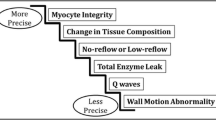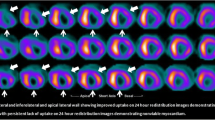Conclusion
The discovery by Rahimtoola that chronic left ventricular regional dysfunction due to prolonged hypoperfusion can recover after full reperfusion has radically changed the current physiopathological concept of myocardial ischaemia and the actual treatment of CAD patients. We need, however, proper studies aimed to evaluate the role of the different diagnostic metodologies for detection of myocardial hibernation and to assess the clinical efficacy of revascularization of hibernating myocardium in terms of reduction of morbidity and mortality. From the clinical point of view attention and resorces should be concentrated on those case with large extension of hibernating myocardium, in which the differentiation of viable from non-viable myocardium and the stratification of operative risk is the real overriding clinical concern. It is this subset of patients which will justify further investigation in this fascinating field and which hopefully, will improve our therapeutical possibility.
Similar content being viewed by others
References
Rahimtoola S (1989) The hibernating myocardium. Am Heart J 117: 211–221
Eitzman D, Al-Aouar Z, Kanter HL (1992) Clinical outcome of patients with advanced coronary artery disease after viability studies with positron emission tomography. J Am Coll Cardiol 20: 559–565
Dilsizian V, Bonow R (1993) Current diagnostic techniques of assessing myocardial viability in patients with hibernating and stunned myocardium. Circulation 87: 1–20
Giubbini R, Alfieri O, Ferrari R, Milan E, Rossini P, Lorusso R, Berra P, La Canna G (1993) Thallium rest-redistribtion and echo-dobutamine tests to predict functional improvement after by pass surgery in patients with left ventricular dysfunction. Circulation 88 (4): 2883
Cigarroa CG, De Filippi CR, Brickner ME, Alvarez LG, Wait MA, Grayburn PA (1993) Dobutamine stress echocardiography identifies hibernating myocardium and predicts recovery of left ventricular function after coronary revascularization. Circulation 88: 430–436
La Canna G, Alfieri O, Giubbini R, Gargano M, Ferrari R, Visioli O (1994) Echocardiography during infusion of dobutamine for identification of reversible dysfunction in patients with chronic coronary artery disease. J Am Coll Cardiol 23:617–626
Ferrari R, La Canna G, Giubbini R, Ceconi C, Pardini A, Coletti G, Berra P, Alfieri O (1994) Hibernating myocardium. In: Eds. M Yacoub, J. Pepper (eds) Annual of Cardiac Surgery, pp 28–32
Author information
Authors and Affiliations
Rights and permissions
About this article
Cite this article
Ferrari, R. Commentary on hibernating myocardium and its clinical relevance. Basic Res Cardiol 90, 52–54 (1995). https://doi.org/10.1007/BF00795121
Issue Date:
DOI: https://doi.org/10.1007/BF00795121




